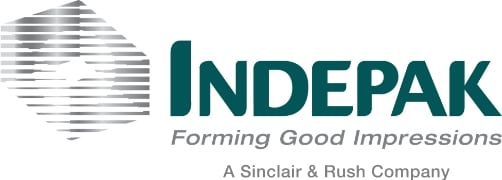Whether you need packaging for food or medications or retail products, vacuum thermoformingcan make it happen. This is the process used to create blister packaging, clamshell packaging, thermoform trays, plastic bottles and much more. Here’s a quick look at the process and some fun facts about the history of thermoforming and plastic packaging.
At Indepak, we use high-speed thermoforming machines to create our packaging. After a design and prototype has been approved, we develop the mold for your product, which is placed into the machine. Large, thin sheets of plastic will be fed into the vacuum thermoforming machine and these sheets will be heated until they are malleable and then forced onto the mold using a combination of pressure and vacuum force.
While natural rubbers and natural cellulose have been used for thousands of years, the development of synthetic plastics really got its start during the 19th century. Celluloid was the world’s first highly usable plastic, and was developed by John Wesley Hyatt. His invention was an improvement on Parkesine, a plastic that had been developed by Alexander Parkes, an English inventor. In addition to improving celluloid, Hyatt also patented the first injection molding machine, a predecessor of the type of machines we use at Indepak today.
As with many industrial advancements, many strides in vacuum thermoforming occurred just before, during and after World War II. There were also many improvements in the development of plastics during these years as durable, lightweight and synthetic materials were in high demand. The first thermoforming machine patents were filed by H.L. Helwig of the Rohm & Hass Company, as well as R.E. Leary, an engineer at DuPont. These early inventors used many different methods to heat up plastic, such as using convection, radiant heat or even hot oil or steam.
In 1947, G.W. Borkland filed a patent for a “vacuum forming” machine. Borkland would go on to make many other improvements in the world of vacuum thermoforming. By the early 1950s, advertisements and articles for vacuum thermoforming equipment would be displayed prominently in publications such as Modern Plastics Magazine and Plastics World.
During the 1940s, many of the plastics we use today also were developed, including polyethylene terephthalate, or PET, which now is used as packaging for hundreds of products as well as for plastic water bottles. From the 1950s onward, improvements continued to be made, both in vacuum thermoforming equipment as well as the development of plastics, in general. For instance, high-density polyethylene was created in 1953 by chemist Karl Ziegler, who later won the Nobel Prize for this invention.
Throughout the last few centuries, chemists and inventors have worked to develop synthetic plastics as well as developing vacuum thermoforming machines, but scientists also continued to work on the production of using natural substances to create plastics. Maurice Lemoigne, for example, developed a bioplastic known as polyhydroxybutyrate in 1926.
For many years, this development was ignored as it was simply easier and less expensive to use petroleum-based plastics. In the 1970s, petroleum shortages and a rise in environmentalism increase interest in the development of bioplastics, and today many packaging companies, Indepak included, offer this type of plastic if our clients wish to create packaging from a renewable source, such as starch.
No matter what type of plastic you choose for your vacuum thermoforming project, consumers should be able to recycle it by simply tossing it into their recycling bin. Virtually every material we use at Indepak is recyclable, and we strive to be a low-waste operation in general. If you need any type of rigid plastic packaging, don’t hesitate to give our vacuum thermoforming experts a call.





